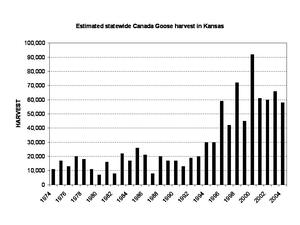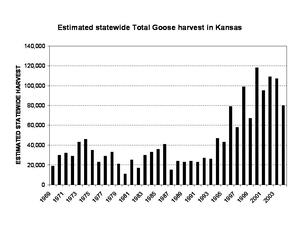HARVEST
.A number of population and harvest surveys are conducted annually that are utilized in the development of waterfowl management programs and regulations. To view data for Kansas and the Central Flyway, click here.
Light Geese - The harvest trend of light geese in Kansas is surprising. Despite the population growth
through the 60’s, 70’s, 80’s and 90’s, the Kansas regular season light goose harvest remained relatively unchanged during those years, averaging about 6,200 birds per year. However, harvest has jumped during recent years, averaging almost 18,000 for the 1999–03 period. Of particular interest is the harvest of Ross’ geese. For many years these small geese were considered rare, and the bag limit was held at no more than one bird per day. From 1962 through 1989 only 123 were recorded in the Federal Harvest Survey for the state of Kansas. Beginning in the mid 90’s they began showing up in the harvest on a regular basis and in 2003 an estimated harvest of 5,800 occurred in Kansas. It is believed that much of this harvest occurs in the western one third of Kansas, where Ross’ geese are commonly observed in light goose flocks belonging to the Western Central Flyway Population of Light Geese.
Light Goose Conservation Order - The present challenge associated with light geese is to correct overabundant populations and resulting habitat problems they cause. There had been a steady procession of hunting liberalizations from the mid 80’s through the mid 90’s, but these proved too little, too late, and light goose population continued to grow. It became obvious that the light goose harvest had been maximized through what could be accomplished within the hunting frameworks allowed by treaty. In 1999, the U.S. Fish and Wildlife Service authorized a Conservation Order harvest of light geese. This Conservation Order allows the take of light geese outside the normal October 1 through March 10 treaty parameters, and authorized new regulations such as the use of unplugged shotguns, electronic calls, and shooting hours extending 1/2 hour after sunset.
Within Kansas, the Conservation order allows the take of geese beginning immediately after the end of the regular season until April 30. During this season, Kansas hunters have harvested about 23,000 additional light geese per year, in addition to those taken during the regular season. It is obvious from the harvest estimates that the Conservation Order Season is important to Kansas Hunters and the final harvest total.
It is too early to determine whether the added harvest allowed by the Conservation Order Season will reverse the growth of the mid-continent light goose population. However, to date the results are encouraging. Winter counts peaked in 1997-98 and appear to have stabilized or even declined slightly since then. Only time will tell. In any event, hunters will undoubtedly be major contributors to the solution of this problem.
White-fronted Geese – Historically, white-fronted geese have not been a major harvest species in Kansas. From 1962 through 1999, the harvest averaged less than 2,000, and never exceeded the 6,000 birds harvested in 1972. However, during recent years (2000–03) whitefront numbers have increased, and they are staying longer. The result is that the harvest has increased accordingly. During these four years the harvest has averaged about 9,000 birds.
Canada Geese – Canada geese are the primary target of Kansas goose hunters. There have been some impressive changes in the harvest of these birds in our state since the early 1960’s. During the
60’s, Canada goose harvest averaged less than 10,000. The harvest gradually increased though the 70’s, 80’s and early 90’s. However, from the late 90’s through the 2003 season there has been a rather dramatic increase in the take of Canada geese in Kansas. During the 1999 through 2003 seasons, Kansas hunters harvested an average of almost 92,000 Canada’s, with a peak harvest of 124,000 in 2003. During 2002 and 2003, for the first time in history, the harvest of Canada geese exceeded the harvest of mallards in Kansas.
Another significant change in the harvest of Canada geese is the proportion of the harvest that is composed of large Canada’s. During the 1960’s only about 25 percent of the Canada goose harvest was large birds. This figure has increased over the years, and has occasionally exceeded 80 percent during recent years. What has occurred is that the total harvest of small Canada geese has remained relatively unchanged while harvest of large Canada’s has increased dramatically.
All Goose Harvest - The total Kansas harvest of all goose species combined has tracked the population trends, increasing from about 11,000 per year during the 60’s, to about 38,000 average
during the 1990’s. However, during recent years there has been a dramatic increase in the total goose harvest, with an estimated average annual harvest approaching 118,000 during the past five years (1999-03), and peaking at 160,000 in 2003.
There have been some minor changes in the species composition of the harvest. During the 1960’s, Canada geese comprised 60 percent of the Kansas harvest, increasing to 72 percent during the 1990’s. This increase has come at the expense of white-fronted geese, which decreased from approximately 10 percent during the 60’s to 3 percent during the 90’s, and light geese, which saw their proportion of the Kansas harvest drop from 31 percent to 25 percent. This change in the species make-up of the Kansas goose harvest is due to the large increase in harvest of Canada geese.
The recreational value of the harvest and hunter opportunity provided by geese in the Central Flyway and Kansas is obvious. However, their widespread range, high visibility, and tolerance of close human contact results in geese, both resident Canada as well as winter concentrations, being the most observed wildlife in Kansas. Because of this, the non-consumptive benefits of geese, and waterfowl in general, are probably greater than that provided by any other species we manage.
The growth of our goose populations has been matched with the liberalization of hunting regulations. During the 1960’s, 70’s and 80’s goose hunting regulations were relatively restrictive in the Central Flyway, as managers tried to build populations and establish nesting resident Canada geese. During the 1964 waterfowl season, Kansas hunters were allowed a 75 day goose season running from October 3 through December16, with a bag limit of 5 geese, which could include no more than 1 Ross’ goose, 2 Canada geese, or 1 Canada and 1 white-fronted goose. In 2005, Kansas hunters were allowed an 84 day white-fronted goose season with a bag limit of 2 whitefronts, a 95 day Canada goose season with a bag limit of 3 Canada geese, and a 107 day light goose season with a bag limit of 20.













